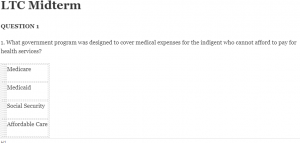LTC Midterm

QUESTION 1
1. What government program was designed to cover medical expenses for the indigent who cannot afford to pay for health services?
| Medicare | ||
| Medicaid | ||
| Social Security | ||
| Affordable Care |
5 points
QUESTION 2
1. Consumer demand was the catalyst for the creation of community based programs
True
False
5 points
QUESTION 3
1. Who owns and operates the overwhelming majority of assisted living facilities?
| for profit organizations | ||
| not for profit organizations | ||
| managed care organizations | ||
| the government |
5 points
QUESTION 4
1. The long-term care system works best when it maintains its focus on medical treatment, rather than being distracted by quality of life and other non-medical or non-clinical services.
True
False
5 points
QUESTION 5
1. Why does subacute care appeal to reimbursers such as Medicare, MCOs, and private insurance companies, as an option to hospitalization?
| The clear regulations make them easier to work with | ||
| The lack of regulations allows the reimburser to set rates | ||
| The reimburser has mre control over the services that are provided | ||
| They provide required services for consumers at a lower cost |
5 points
QUESTION 6
1. One difference between subacute care and postacute care is that subacute care provides outpatient services, while postacute care provides inpatient services.
True
False
5 points
QUESTION 7
1. An admission to a nursing facility for a consumer who cannot remain at home because of disabilities or care needs would best be categorized as a:
| choice-based admission | ||
| Family-initiated admission | ||
| need-driven admission | ||
| MD initiated admission |
5 points
QUESTION 8
1. Whether a subacute care unit is freestanding or physically housed within a larger facility, it will most likely be affiliated with, or even owned and operated by, a hospital or nursing facility.
True
False
5 points
QUESTION 9
1. A residential setting for seniors that might provide supportive services is called
| Assisted living | ||
| Independent living | ||
| Nursing Home | ||
| Continuing Care Retirement Community |
5 points
QUESTION 10
1. Rather than simply maintain their current quality of life, most seniors moving into senior housing want their quality of life to improve.
True
False
5 points
QUESTION 11
1. A senior housing complex that is built by a municipality to serve the needs of its citizens is an example of a facility that is:
| publicly owned | ||
| owned by for profit investors | ||
| privately owned | ||
| owned by an MCO |
5 points
QUESTION 12
1. Medicare reimbursement is available for certified home health and hospice care providers, but not for adult day care.
True
False
5 points
QUESTION 13
1. The basic philosophy of home health care is to:
| provide services for both the patient and the caregiver | ||
| approach health care in a holistic manner | ||
| take the healthcare services to the consumer | ||
| give comfort and support to the patients and his or her family |
5 points
QUESTION 14
1. Since assisted living facilities focus primarily on quality of life and autonomy for consumers, they must contract with outside agencies in order to provide healthcare services for their residents.
True
False
5 points
1. Residents who move from an independent living community to an assisted living facility most often do so because of:
| increased functional capacity | ||
| dissatisfaction with the services provided | ||
| decreased independence or functional ability | ||
| desire to be closer to family |
5 points
QUESTION 16
1. A hospital that purchases a nursing home and a home care agency is creating a horizontally integrated system
True
False
5 points
QUESTION 17
1. One weakness of the current long-term care system is that it focuses on payment availability. The reason it has this focus is that:
| services are distributed unequally. | ||
| it is a reimbursement-driven system. | ||
| it is a fragmented system. | ||
| there are multiple entry points into the system |
5 points
QUESTION 18
1. Given the philosophy of hospice, palliative care is more important that curative care
True
False
5 points
QUESTION 19
1. What is true about accreditation?
| It is required by law for all long term care providers. | ||
| There are mandated penalties for not being accredited.
|
||
| It is the process by which agencies are listed as eligible to provide a regulated service.
|
||
| It is given by private agencies that are funded by the participating providers.
|
5 points
QUESTION 20
1. The vast majority of all long term care facilities are owned by for-profit organizations.
True
False
5 points